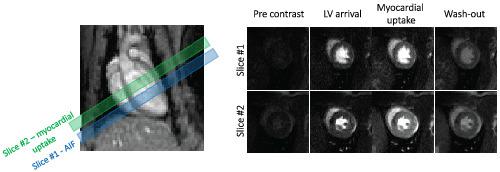当前位置:
X-MOL 学术
›
NMR Biomed.
›
论文详情
Our official English website, www.x-mol.net, welcomes your
feedback! (Note: you will need to create a separate account there.)
Quantitative myocardial first-pass perfusion imaging of CO2-induced vasodilation in rats
NMR in Biomedicine ( IF 2.7 ) Pub Date : 2021-08-02 , DOI: 10.1002/nbm.4593 Grzegorz Kwiatkowski 1 , Sebastian Kozerke 1
NMR in Biomedicine ( IF 2.7 ) Pub Date : 2021-08-02 , DOI: 10.1002/nbm.4593 Grzegorz Kwiatkowski 1 , Sebastian Kozerke 1
Affiliation

|
Inducible hypercapnia is an alternative for increasing the coronary blood flow necessary to facilitate the quantification of myocardial blood flow during hyperemia. The current study aimed to quantify the pharmacokinetic effect of a CO2 gas challenge on myocardial perfusion in rats using high-resolution, first-pass perfusion CMR and compared it with pharmacologically induced hyperemia using regadenoson. A dual-contrast, saturation-recovery, gradient-echo sequence with a Cartesian readout was used on a small-animal 9.4-T scanner; additional cine images during hyperemia/rest were recorded with an ultrashort echo time sequence. The mean myocardial blood flow value at rest was 6.1 ± 1.4 versus 13.9 ± 3.7 and 14.3 ± 4 mL/g/min during vasodilation with hypercapnia and regadenoson, respectively. Accordingly, the myocardial flow reserve value was 2.6 ± 1.1 for the gas challenge and 2.5 ± 1.4 for regadenoson. During hyperemia with both protocols, a significantly increased cardiac output was found. It was concluded that hypercapnia leads to significantly increased coronary flow and yields similar myocardial flow reserves in healthy rats as compared with pharmacological stimulation. Accordingly, inducible hypercapnia can be selected as an alternative stressor in CMR studies of myocardial blood flow in small animals.
中文翻译:

CO2诱导大鼠血管舒张的定量心肌首过灌注成像
诱导性高碳酸血症是增加冠状动脉血流量的替代方法,以促进充血期间心肌血流量的量化。目前的研究旨在量化 CO 2的药代动力学效应。使用高分辨率、首过灌注 CMR 对大鼠心肌灌注的气体挑战,并将其与使用热加腺苷的药物诱导充血进行比较。在小型动物 9.4-T 扫描仪上使用具有笛卡尔读数的双对比度、饱和度恢复、梯度回波序列;用超短回波时间序列记录充血/休息期间的其他电影图像。静息时的平均心肌血流量值分别为 6.1 ± 1.4 和 13.9 ± 3.7 和 14.3 ± 4 mL/g/min,在高碳酸血症和热加腺苷的血管扩张期间。因此,气体激发的心肌流量储备值为 2.6 ± 1.1,热加腺苷的心肌流量储备值为 2.5 ± 1.4。在两种方案的充血期间,发现心输出量显着增加。得出的结论是,与药物刺激相比,高碳酸血症导致健康大鼠的冠状动脉流量显着增加并产生相似的心肌流量储备。因此,在小动物心肌血流的 CMR 研究中,可以选择诱导性高碳酸血症作为替代压力源。
更新日期:2021-08-02
中文翻译:

CO2诱导大鼠血管舒张的定量心肌首过灌注成像
诱导性高碳酸血症是增加冠状动脉血流量的替代方法,以促进充血期间心肌血流量的量化。目前的研究旨在量化 CO 2的药代动力学效应。使用高分辨率、首过灌注 CMR 对大鼠心肌灌注的气体挑战,并将其与使用热加腺苷的药物诱导充血进行比较。在小型动物 9.4-T 扫描仪上使用具有笛卡尔读数的双对比度、饱和度恢复、梯度回波序列;用超短回波时间序列记录充血/休息期间的其他电影图像。静息时的平均心肌血流量值分别为 6.1 ± 1.4 和 13.9 ± 3.7 和 14.3 ± 4 mL/g/min,在高碳酸血症和热加腺苷的血管扩张期间。因此,气体激发的心肌流量储备值为 2.6 ± 1.1,热加腺苷的心肌流量储备值为 2.5 ± 1.4。在两种方案的充血期间,发现心输出量显着增加。得出的结论是,与药物刺激相比,高碳酸血症导致健康大鼠的冠状动脉流量显着增加并产生相似的心肌流量储备。因此,在小动物心肌血流的 CMR 研究中,可以选择诱导性高碳酸血症作为替代压力源。











































 京公网安备 11010802027423号
京公网安备 11010802027423号